When backpacking or thru-hiking, you need foods which are loaded with calories but still light enough to carry. That’s why you’ll find so many hikers eating Fritos for dinner (or making meals like “Frito pie”).
Sorry to break it to you, but those calorie-dense junk foods aren’t the best choice. Nutrition — and not just calories — matters when backpacking!
If you are relying on junk foods for your calories when backpacking, you’ll likely end up tired and undernourished. Here’s a quick primer on backpacking nutrition and a list of calorie-dense backpacking foods which actually contain nutrients.
Jump to:
- Backpacking Nutrition 101
- Why not just eat junk food?
- Nuts and seeds: not as high-calorie as listed
- List of calorie-dense healthy foods
- Tips for using calorie-dense foods in your backpacking meals
*Guess what? I wrote a book. It’s got over 50 healthy recipes for backpacking, plus tons of info on how to plan meals. Learn more here.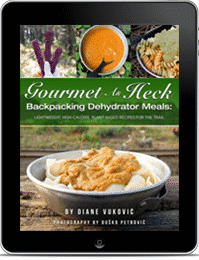
Backpacking Nutrition 101
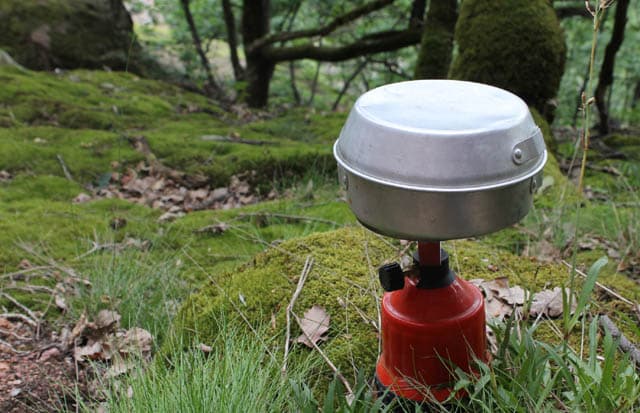
Backpacking nutrition is a really complex subject. And, while there is tons of research into nutrition for athletes like marathon runners, there is very little research about backpacking nutrition. Here’s the gist of what you need to know:
Where Calories Come From
A calorie is just a unit of measurement. They do NOT give us energy! However, calories do come from nutrients which can provide energy for us. These are carbs, proteins, and fats.
- Carbs: 1 gram of carbs = 4 calories
- Proteins: 1 gram of protein = 4 calories
- Fats: 1 gram of fat = 9 calories
As you can see, fats are the most calorie-dense foods available. However, our bodies primarily use glycogen (which comes from carbs) as energy when backpacking. Thus, it is important to include a lot of carbs in your backpacking diet and not just fatty foods. You also need proteins to help repair muscles.
Ratio of Carbs to Fats to Proteins
When planning your backpacking meals, you want most of your calories to come from carbs. The next biggest chunk of calories should be from fat and the remaining from protein. Here’s how it breaks down:
- 50% of calories from carbs
- 35% from fat
- 15% from protein
*There is a lot of conflicting advice on these ratios. However, this is the most common recommendation.
Why Not Just Junk Food?
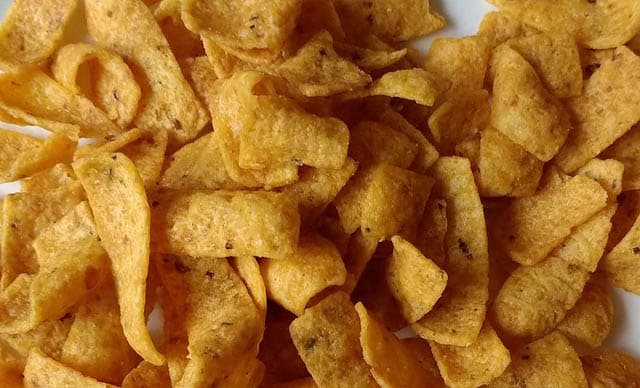
As far as calorie-density goes, junk food like Fritos and Pringles come out on top. And, if there is ever a time to eat junk food, it is while your body is actively burning through calories while you hike.
But junk food isn’t the best solution for lightweight backpacking food. Junk food is completely lacking in micronutrients which your body needs for things like preventing muscle cramps, delivering oxygenated blood throughout the body, and keeping your mind sharp.
The sugary carbs found in most junk food will also cause your blood sugar to spike quickly and crash. That means you end up tired and hungry.
On top of this, the fats found in junk foods are usually long chain tryglicerides (LCTs) The body isn’t very good at converting these into energy. By contrast, the medium chain triglycerides (MCTs) which are found in healthy sources of fat don’t have as many calories per weight. However, the body converts these healthy fats into energy much faster and efficiently. (1, 2)
*For more on this topic, read this in-depth Guide to Backpacking Nutrition.
Nuts and Seeds As a Calorie-Dense Food?

Nuts and seeds are usually considered the “best” healthy backpacking food in terms of calorie-density. Yes, they do contain loads of calories per ounce plus a lot of protein and healthy fats.
But, if you’ve ever dug a cathole while backpacking, then you know much of those nuts are going to waste! You’ll often see entire pieces of nuts in your poop!!! Obviously, a lot of those calories are never entering your system.
Understand that calories are calculated using an outdated, inaccurate method. They take the food, burn it, and calculate how much energy is created. Our bodies don’t burn up food though! This is why studies (like the ones reported on here and here) have found that almonds and walnuts contain around 20-32% fewer calories than the label indicates!!!!
So, does that mean nuts aren’t a good backpacking food?
Not necessarily. Studies have found that chewing nuts – I mean really chewing them – results in more calories and fat being absorbed by the body. Likewise, studies have found that virtually all of the calories from nut butters are absorbed.
The bottom line? To get maximum calories from your nuts/seeds on the trail:
- Chew them thoroughly!
- Or bring nut butters instead of whole nuts
*I actually make really cool dehydrated sauces out of blended nuts, like the cashew-tomato sauce on the pasta shown below. It’s really filling and insanely calorie-dense. You can get the recipe in my eBook.
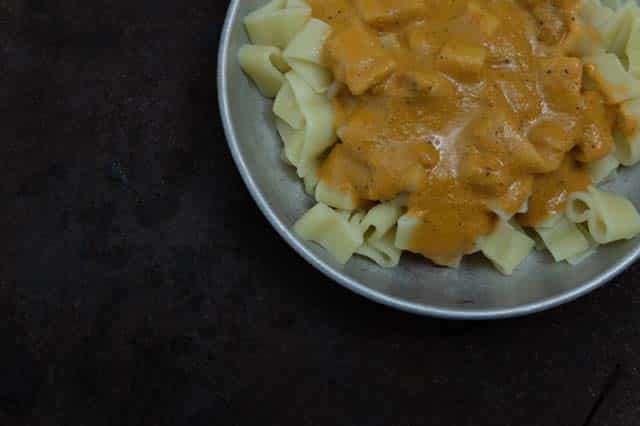
This cashew pasta sauce has 163 calories/oz when dehydrated!
List of Calorie-Dense Backpacking Foods
*Calories listed per 100 grams (3.5oz)
**The amount of calories in a food can vary. A range or approximation has been given for some of the foods.
- Oil: 800-900 calories
- Macadamia nuts: 718 calories
- Pecans: 716 calories
- Pine nuts: 673 calories
- Dried coconut milk powder (buy here) About 660 calories
- Desiccated coconut meat: 590-660 calories
- Brazil nuts: 656 calories
- Walnuts: 654 calories
- Hazelnuts: 629 calories
- Sunflower seeds: 619 calories
- Dehydrated hummus: 606 calories
- Peanut butter: About 600 calories
- Almonds: 581 calories
- Dark chocolate: 578 calories
- Cashews: 574 calories
- Freeze-dried whole egg powder: 570-615 calories
- Flax meal: About 500 calories
- Dehydrated or freeze-dried beans: 350-500 calories
- Chia seeds: 490 calories
- Bacon bits (meatless): 476 calories
- Roasted soy beans: 471 calories
- Granola: 300-490 calories
- Whole wheat crackers: 443 calories
- Parmesan cheese: 431 calories
- Cacao (not cocoa!) powder: 400 calories
- Hemp protein powder: 387 calories
- Meat jerky: About 315-410 calories
- Whey protein powder: 375-405 calories
- Tofu jerky (store bought): About 350 calories
- Dried fruit (unsweetened): About 240-300 calories
- Tortillas: 200-300 calories
- Bagels: 250 calories
Tips for Using High-Calorie Backpacking Foods
You’ve read that foods like coconut milk powder and cacao have lots of calories. But how the hell do you use these? It’s not like you are going to choke back dry powders on the trail!
Here’s how I incorporate calorie-dense nutritious foods with other ingredients to make tasty backpacking meals.
1. Add Healthy Oil to Your Starchy Meals
Just bring along a little bottle of a healthy oil with you on the trail (such as olive oil or coconut oil). Whenever you make quick-cook meals (such as couscous, pasta, or other starchy foods that lack calories), just add a squirt or two of oil. The oil will also make the food taste much more satisfying.
2. Dehydrate Beans and Proteins
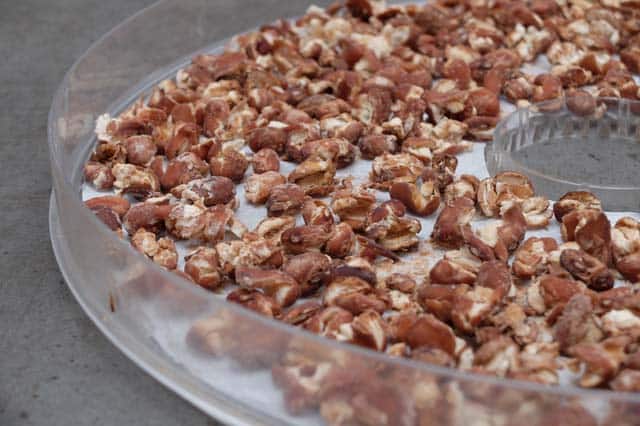
Dehydrated beans
Beans are actually very high in calories. The issue is that you can’t cook dry beans on the trail and carrying canned beans backpacking is idiotic.
Other than instant hummus mix, there aren’t too many trail-friendly solutions for beans.
My solution? I just dehydrate my own. 🙂 Cook the beans (or buy canned) and dehydrate them until they are very dry. They rehydrate very quickly. You don’t even need to cook them to rehydrate. Just add water and let them sit for about 10 minutes.
Take your dehydrated beans and add them to starchy dishes. Or rehydrate them to use in tortillas or spread on bagels.
*Check out my eBook with over 50 dehydrator backpacking recipes. They are all insanely calorie-dense and lightweight! Just add water and you’ll get a healthy meal. 😀 Get the eBook here.
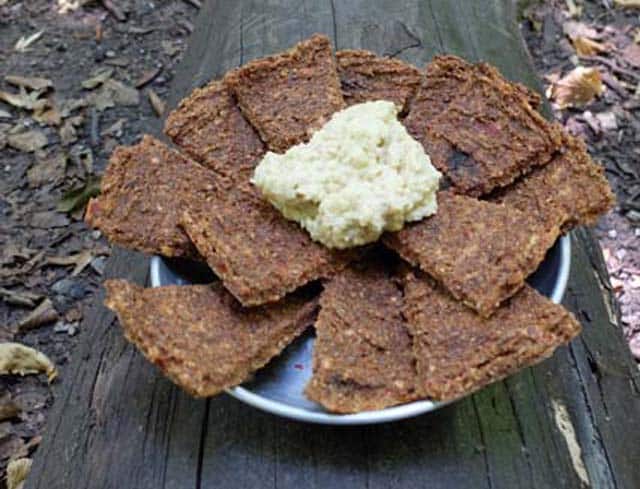
Re-hydrated hummus on top of homemade dehydrator red pepper & seed crackers – this combo is LOADED with calories! Get the recipe in my eBook here.
3. Using Coconut Milk Powder
I am in love with coconut milk powder! It is very high-calorie and contains healthy fats. Just carry a baggy of it with you on the trail. Add a scoop to your meals. It is particularly good in soups.
*Don’t mix any milk powder with dehydrated ingredients. There is moisture in the ingredients which will “activate” the milk powder and make it go bad. Wait until your meal is cooking to add the coconut milk powder!!!
You can buy coconut milk powder on Amazon. You might also find it in Indian stores, if you have one near where you live.
- Nutricost dehydrated coconut milk powder – 189 calories per ounce (6.66 calories per gram)
- Opportunity organic dehydrated coconut milk powder – 193 calories per ounce (6.83 calories per gram)
4. DIY Energy Bars with Protein Powder
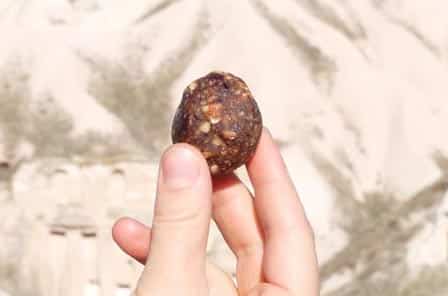
Making your own energy bars is really easy. Once you start doing it, you’ll probably never want to buy those overpriced bars again. I often add protein powder to my bars to give them an extra nutritional kick.
Eating protein powders is actually better than drinking it. Liquid calories get absorbed very quickly, causing that spike-then-crash. You’ll get much more sustainable energy if you mix the protein powder with solid foods!
Here’s a recipe for one of my favorite DIY energy bars (rolled them into balls but they could be flattened into bars too). They have COFFEE in them so they really wake you up! 😀
Recipe:
- Dehydrated banana slices, from 1 banana
- 1 cup dried cherries
- 1/2 cup almonds
- 1 cup pitted dates
- 1 Tbsp. instant coffee (or more if you like!)
- 1/4 cup neutral-tasting protein powder (I used coconut protein powder)
Instructions:
- Add a bit of each ingredient to a food processor and pulse
- Gradually keep adding ingredients and pulsing
- The mixture will come together. There should still be some chunks. You don’t want a paste!
- Form into balls.
This recipe has 161 calories per ounce. You can get this recipe and more in my eBook here.
5. Add Cacao to Meals
Cacao is an awesome backpacking food because it has lots of calories as well as nutrients like zinc and antioxidants. Note that cacao is NOT the same as cocoa! Cocoa only has about half the calories and doesn’t contain the nutrients.
You can easily incorporate cacao into homemade protein bars. Or, add a scoop of it to your breakfast oatmeal. There are also these little packs of fancy hot chocolate made from real cacao. Sip one for dessert – they contain about 100-120 calories per ounce. Equal Exchange Organic Hot Cocoa Mix (contains milk) has 116 calories per oz/ 4.1 calories per gram.
6. Nuts and Maximizing Calories
As mentioned before, many of the calories in nuts don’t get absorbed. Even considering a loss of up to 30%, nuts still have lots of calories and are great trail snacks.
Instead of just eating nuts in your GORP though, you can incorporate them into your meals. I’ve got a lot of these nut-based recipes in my eBook.
If you want to keep things simple, consider sprinkling sunflower seeds on your pasta or adding flax meal to your oatmeal.
Also read: How to Carry Peanut Butter Backpacking
7. Make DIY Freeze-Dried Meals
Freeze-dried meals from companies like Mountain House are very convenient. But they are also very expensive (especially considering that they mostly contain rice or pasta). Since you’ll probably need to eat two bags to feel full, they aren’t even that great in terms of weight.
Instead of buying freeze-dried meals, you can easily make your own. Just buy bulk freeze dried foods and combine them with dry ingredients from the supermarket (like couscous, pasta, or instant rice). You can read this guide to making your own DIY freeze dried meals from bulk ingredients.
Want more advice on backpacking food? Check out these posts:


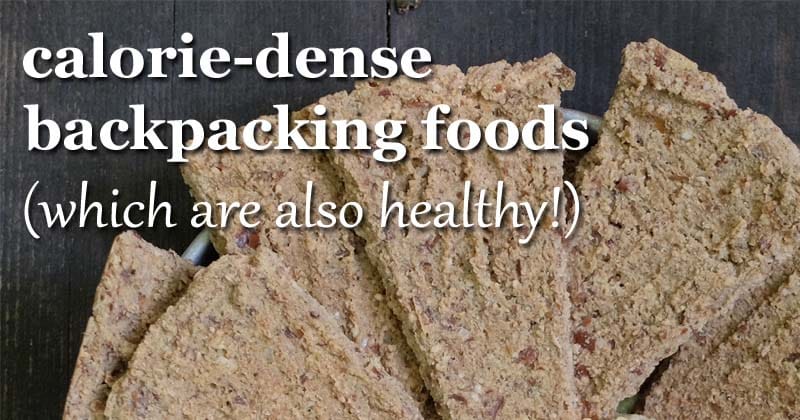
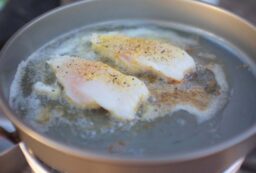
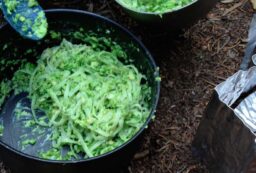
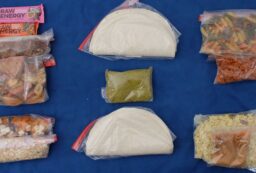







4 Comments
Daniel
August 26, 2020 at 7:46 pmYou mentioned in the article that we don’t absorb all the calories from nuts listed on the label. I found this so fascinating that I went to look up the source of this info: https://agresearchmag.ars.usda.gov/2018/mar/calories/
In this study, it says that almond butter still had a reduction in calories of 17% compared to 25% for whole almonds. Just wanted to give you a heads up that making nut butter like you mentioned above may be a waste of time! haha 😉
Diane
August 28, 2020 at 2:56 pmWe actually don’t consume all the calories in many of the foods we eat, so I’m not sure how 17% compares to foods like rice, berries, dried fruit, beans etc. Anyone who pays attention when pooping in a cathole will know that a lot of foods are going straight through — not just nuts! 😀
Jorge Molina
June 10, 2023 at 3:00 amGreat article. The information provided will be put to use on my trek in a few weeks. Thanks Diane!
Tommy
April 28, 2022 at 7:48 pmGood article! Thanks for the ideas and links… Coffee in homemade energy balls… I’m going to try that!